Your faux leather jacket is starting to peel. What do you do? Do you toss it in the trash, or is there a way to fix it? In this definitive guide, we will answer all of your questions and give you tips on how to fix a peeling faux leather jacket. Whether the issue is with the stitching, the fabric, or the coating, we have you covered. So grab your jacket and let’s get started!
Faux Leather in General
While faux leathers have become increasingly durable in recent years, they’re still not as resilient as genuine leather when exposed to extreme temperatures or moisture. Because of this, faux leather can begin to crack, peel, or fade if not cared for properly. This can make your faux leather jacket look worn and outdated, but, fortunately, there are a few steps you can take to help fix it. [1] [2] [3] [4]
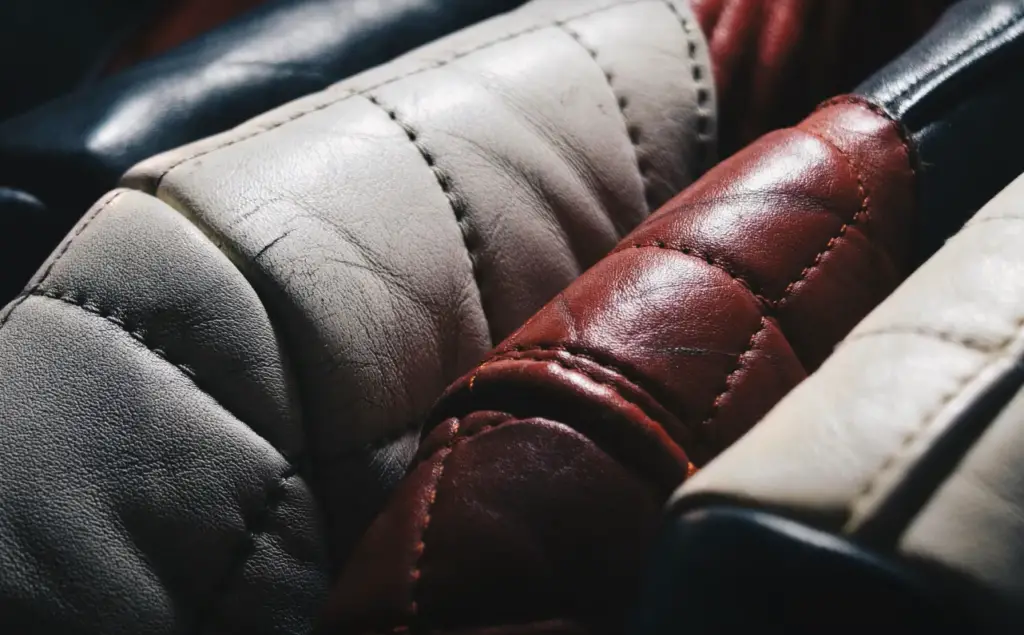
What Causes Faux Leather to Peel?
Before we get into how to fix a peeling faux leather jacket, it’s important to understand why this problem can occur in the first place. This will give you a better idea of what to look for when inspecting your jacket, as well as offer a few preventative measures you can take in the future.
Overall poor durability of faux leather
One of the biggest drawbacks to faux leather is that it’s simply not as durable as genuine leather. Over time, its exterior can become dry and start to peel off, while genuine leather will remain intact for much longer. This is why it’s important to inspect your jacket regularly and take proper care of it in order to prolong its life. Still, if you had a faux leather jacket for a long time, it’s a natural consequence that it will start to wear eventually. This is why it’s important to know what steps you can take if your faux leather jacket starts to peel.
Exposure to heat
Extremely hot temperatures won’t do any good for your faux leather jacket. When exposed to direct heat, the surface of the material can become dry and brittle, leading to cracking and peeling. Moreover, many faux types of leather are more prone to fading in the sun, so it’s recommended that you store your jacket away from sources of direct light or ultraviolet radiation.
While this is also the case with genuine leather, faux leather is particularly vulnerable to the effects of heat. This is because genuine leather contains natural oils that help keep it protected and hydrated, whereas faux leather consists mainly of plastic and thus lacks these protective properties.
Prolonged exposure to moisture
Faux leather is also more susceptible to damage when exposed to excessive moisture. This is because water can seep into the material and cause it to swell, leading to peeling or flaking over time. If you must wear your faux leather jacket in wet conditions, be sure to dry it off as soon as possible and store it away from any sources of moisture.
These two factors are why it’s important to never store your faux leather jacket in direct sunlight, as this will cause it to dry out and become brittle over time. It’s also important to invest in a quality waterproofing spray for your jacket if you plan on wearing it during inclement weather.
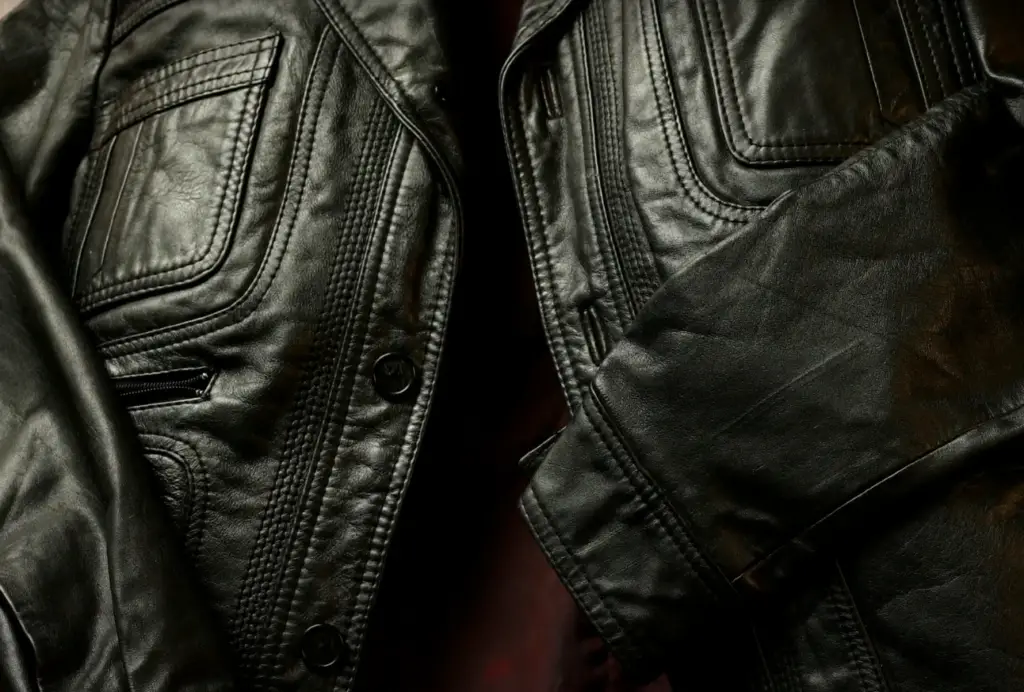
Moreover, if your jacket does get wet, avoid using a hairdryer or other heat source to speed up the drying process. This could cause more harm than good, as heat can cause the material to become brittle and start peeling. Instead, air-dry your faux leather jacket by laying it out flat on a towel with no direct heat source nearby.
Natural aging
Next, faux leather can start to peel due to natural aging. No matter how well you take care of your jacket, its material will eventually start to break down and look worn out over time. This is why it’s important to inspect your jacket regularly and take note of any signs of wear or damage that may be occurring.
Frequent use
Frequent use of your faux leather jacket can also lead to peeling. This is because the material will start to lose its shape and become stretched out over time. If you notice that your jacket has started to show signs of wear due to frequent use, consider investing in a quality leather moisturizer or oils to help prevent further damage from occurring.
Improper maintenance
Finally, if you fail to take proper care of your faux leather jacket, it could start to peel prematurely. Using harsh chemical cleaners or abrasive materials can cause the material to become brittle and start flaking off. Likewise, using too much heat when drying your jacket can also cause premature peeling.
For this reason, it’s important to always read the care instructions that come with your faux leather jacket before cleaning it. These will tell you what types of cleaning products are safe to use and how best to dry it without causing any damage. Following this advice will help ensure that your faux leather jacket stays looking its best for as long as possible. [1] [2] [3]
How to Fix a Peeling Issue in Your Faux Leather Jacket
Now that you know the causes of peeling in faux leather jackets, here are some tips for fixing a peeling issue. In this section, we will discuss four solutions that can help restore your faux leather jacket to looking like new.
Use a permanent marker
One quick and easy way to hide peeling in your faux leather is by using a permanent marker. While this might seem like a strange fix, it’s actually quite a common practice!
To do this, first, get a permanent marker that matches the color of your faux leather. Then, take a very fine grit sandpaper and lightly sand the area that is peeling. Finally, use the marker to fill in any gaps or lines where the faux leather has peeled away. The color of your permanent marker should match perfectly with the color of your jacket so it blends in seamlessly. Make sure you press firmly as you draw over the affected area so that the pigment sticks properly.
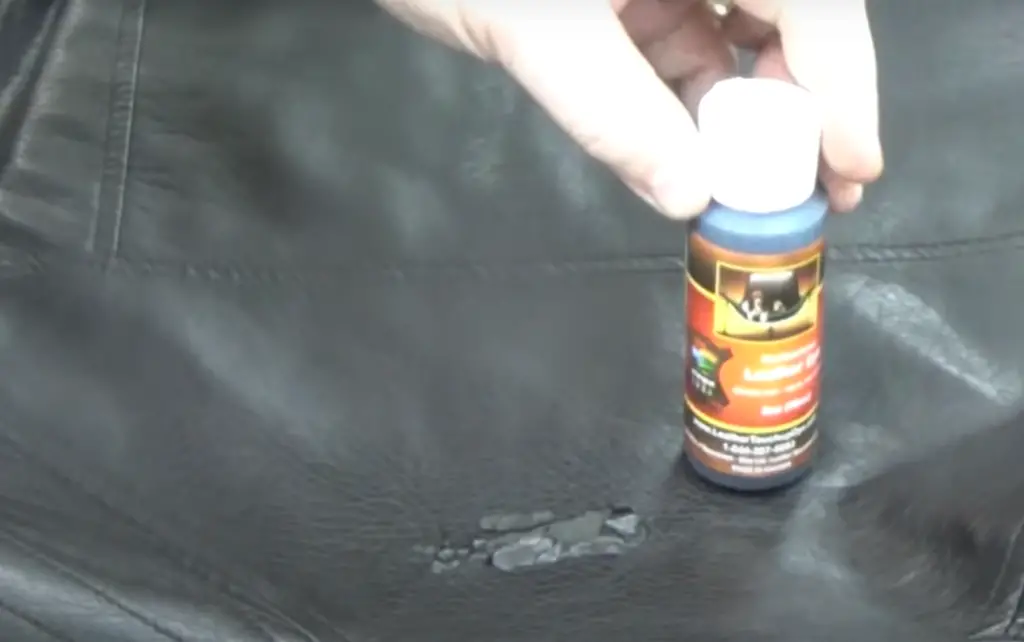
Once applied, leave your faux leather item to air dry for at least 24 hours.
Apply a leather paint
Leather paint is a special type of paint designed to bring new life and shine to leather surfaces. It’s made with a durable, flexible acrylic formula that adheres to the surface of the faux leather, making it resistant to peeling and cracking over time.
And using it is the very common solution to fixing a peeling faux leather issue. You can find special paints designed specifically for faux leather at any craft or fabric store. To apply, sand off any loose pieces of paint, clean the area with a dry cloth and then begin painting using either a brush or sponge. Be sure to read the instructions on the paint packaging as they will provide guidance on how much to apply and how long it should take to dry. After letting the paint fully dry (again, make sure you follow all instructions on drying times), lightly buff the surface for an even finish.
Use a soft filler
A great way to fix a peeling faux leather jacket is by using a soft filler. Soft fillers are an easy and relatively inexpensive solution that can help cover up any holes or tears in your faux leather. They will not be able to repair deep structural damage, but they can help make the issue less noticeable if used correctly.
Start by removing the leather peeling from the jacket. Gently scrape away any loose material and then use a soft cloth to remove the remainder of the peeling. Be very careful not to damage the underlying material.
When using a soft filler, you should use a putty knife or spoon to gently apply a thin layer of the filler material over the area that needs repair. If there are any holes, you can use a brush and fill them in with more of the soft filler. Start with a small amount and work it into the affected area with your fingers. Make sure to work it in until you have completely filled all of the gaps and crevices. Avoid getting soft filler into the seams or any of the stitching as it can damage the material and make the repair job much more difficult.
Once done, let the filler cure for at least 20 minutes, and then wipe away any excess material with a clean cloth.
A nail polish method
This is a simple method that can be used to easily fix small areas of peeling. All you need is a bottle of clear nail polish and a q-tip or cotton swab. Begin by cleaning the area around the peeling with a clean, damp cloth. Make sure to remove any dirt or dust from the area as this can cause additional problems while you are fixing it. And of course, you should remove the peeling too. Once dry, use the q-tip or cotton swab to apply some clear nail polish to the affected area. This will act as an adhesive by hardening and holding the faux leather together.
Attach an extra fabric to the damaged area
This isn’t a method we recommend using if you want your faux leather jacket to look perfect, but it can work as a quick DIY fix. All you need is some fabric and a pair of scissors. Start by cutting a piece of fabric slightly larger than the damaged area. Then use a thread and needle to sew it onto the faux leather. Make sure you use a nice, tight stitch and that the fabric is securely attached.

Once done, you can then paint over the new material with the same color as your jacket. This will help blend everything together and make it look like one piece. Again, this isn’t a method we recommend using if you want your jacket to look perfect, but it can be useful in a pinch if you need a quick fix! [1] [2] [3]
How to Properly Take Care of Faux Leather
As you can see, there are several ways to fix a peeling faux leather jacket. However, the best way to avoid having to deal with this problem altogether is by properly taking care of your faux leather. Let’s dive into some tips on that!
Avoid exposing it to direct sunlight for too long
One of the most important things to remember when dealing with faux leather is that it does not take kindly to direct sunlight for long periods of time. Sunlight can cause the material to fade and become brittle, which can eventually lead to peeling. Therefore, it’s best to keep your faux leather jacket away from direct sunlight whenever possible.
Clean it regularly
Cleaning your faux leather jacket on a regular basis is essential for keeping it looking its best. You should use a damp cloth and mild soap to clean any dirt or debris off the surface, then pat dry with a soft cloth afterward. Make sure you never submerge your faux leather garment in water as this could cause damage.
And avoid harsh cleaning products as these can strip the faux leather of its natural oils and cause it to crack over time. For this reason, you should absolutely stay away from bleach, vinegar, and other harsh chemicals.
Always patch-test the products
Whenever you use a product to fix or clean your faux leather, it’s important to always do a patch test first. This will help ensure that the product won’t damage the material and further compound any existing issues. Just apply a small amount of the product to an inconspicuous area of your jacket and wait for it to dry before continuing with the full treatment.
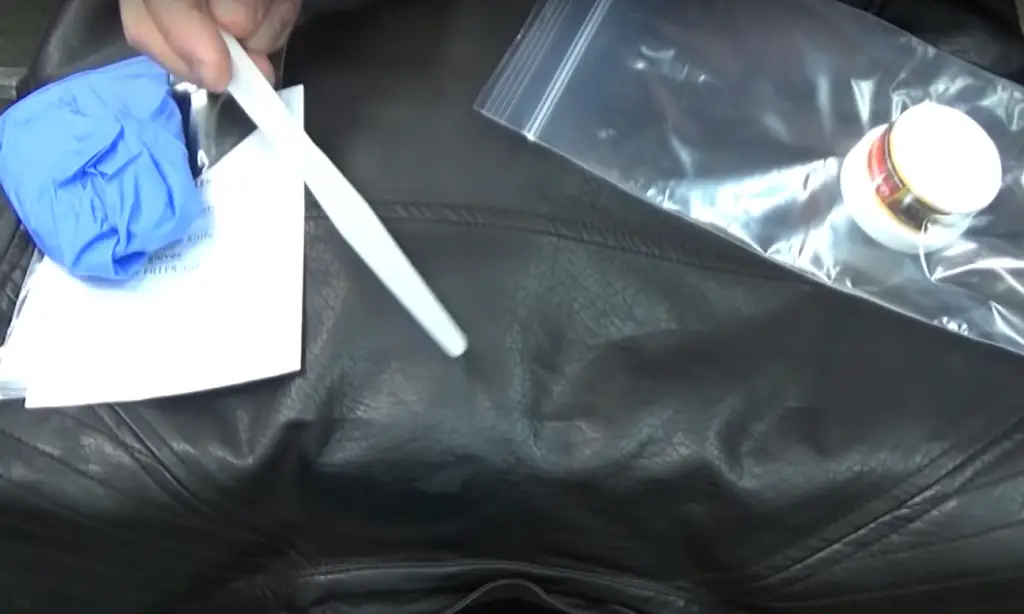
Store it properly
Lastly, when not in use, be sure to store your faux leather jacket in an area that is free of moisture and extreme temperatures. Refrain from hanging them near a heater or air conditioning vent as this could cause damage to the material. And never store faux leather in a plastic bag, as this can trap moisture and cause mold or mildew growth. [4]
FAQ
Is faux leather water-resistant?
However, if you take proper care of your faux leather jacket by applying waterproofing solutions and avoiding contact with water, your faux leather should remain protected for some time.
How do you fix faux leather that’s peeling?
Fixing a peeling faux leather jacket can be a tricky task. It requires patience, the right materials, and knowledge of the fabric you are dealing with. To fix peeling faux leather, start by cleaning the surface of the fabric to remove any dirt or dust that could prevent proper adhesive bonding. Next, sand down the edges of the peeling faux leather jacket with fine-grit sandpaper. Then, apply a thin layer of leather paint or a permanent marker to the edges of the peeling area. If you are using leather paint, let it dry for a few hours until it is completely dry before using your item again. If you’re using a permanent marker, allow the ink to settle in for about thirty minutes.
Can you fix the fake leather jacket peeling?
Yes, you can fix a peeling faux leather jacket. It is possible to restore the look and condition of your faux leather jacket without having to buy a new one. Depending on the severity of the damage, different solutions may be required for repair.
Sometimes, sanding and painting over the affected area can help, but this relies on how much damage has already been done. If the faux leather is too far gone, you may need to apply a patch of new material to cover up any remaining peeling sections.
It’s important to assess the extent of the damage before attempting any repair work—otherwise, it’s likely your jacket won’t look as good after the fix as it did before. It’s best to consult a professional for more severe damages.
Why is my faux leather jacket peeling?
Faux leather jackets are made from synthetic materials such as polyurethane and vinyl, which means they don’t have the same durability as genuine leather. With regular use and exposure to environmental elements like sun, rain, and snow, faux leather can become dry and start peeling. This is due to wear and tear of the surface coating that gives it its unique look.
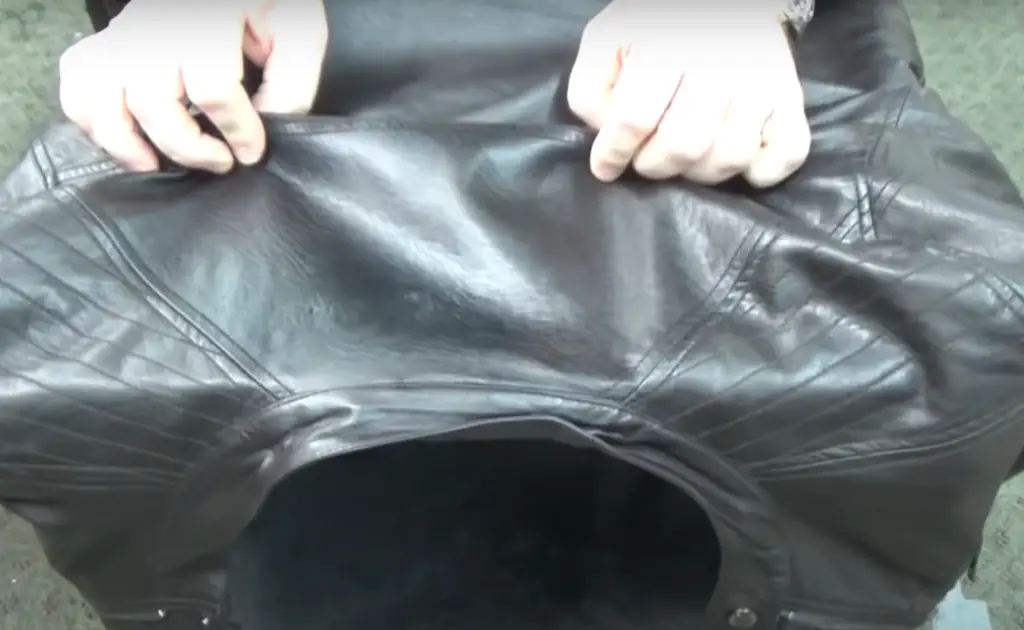
In addition, a faux leather jacket may also begin peeling if it comes into contact with certain fabrics or chemicals like sweat or detergents. As the fabric rubs against another object or material, it causes friction which wears away at the surface coating over time.
Can faux leather be repaired?
Yes, faux leather can be repaired! The first step to repairing a peeling faux leather jacket is to clean the surface of your jacket. Use a cloth dampened (slightly!) in a solution of warm water and mild soap or detergent and use a soft cloth or sponge to gently scrub away any dirt or dust from the surface of the jacket. Once you’ve finished cleaning the jacket, allow it to dry completely before proceeding with any repair process.
Once you’ve allowed your faux leather jacket to dry, you can now start repairing any areas where there is excessive wear and tear. This can include areas that are cracked, split, ripped, or frayed. The exact fix will depend on the type and severity of the damage, so it’s important to assess the situation carefully before attempting any repairs.
In some cases, it’d be cheaper to get a new jacket if the damage is too extensive. But if you want to attempt repairs on your own, there are many adhesive products available specifically formulated for faux leather repair. These can range from simple home-remedy solutions like super glue and fabric glue to more advanced options such as heat sealers, vinyl repair kits, and specialized leather adhesives.
Useful Video: 6 Reasons Faux Leather Jackets Peel
Conclusion
Faux leather is a cheap and stylish alternative to real leather, but when it starts peeling off, it can be a nightmare. Fortunately, with the right products and steps, it’s possible to fix a peeling faux leather jacket.
In this guide, we’ve discussed how to prepare your faux leather for repair and the different types of products you can use to patch the areas that have started to peel or crack. We’ve also discussed steps on how you can take care of and maintain your faux leather jacket in order to prevent future damage from occurring.
Just keep in mind that if the damage is too far gone, it may be time to invest in a new faux leather jacket. But with the right approach and products, you can save you peeling faux leather jacket and extend its life.
If you follow these tips properly, you should be able to restore your faux leather jacket in no time! With proper maintenance, you can make sure that your faux leather stays looking great for many years to come. Now that you know how to fix a peeling faux leather jacket, it’s time to get started! Good luck and happy repairs!
References:
- https://independencebrothers.com/blogs/leather-jackets/faux-leather
- https://home.onehowto.com/article/how-to-repair-a-peeling-faux-leather-jacket-13146.html
- https://favoredleather.com/why-faux-leather-jackets-peel/
- https://www.danetti.com/blogs/lifestyle/our-top-tips-on-how-to-properly-care-for-faux-leather

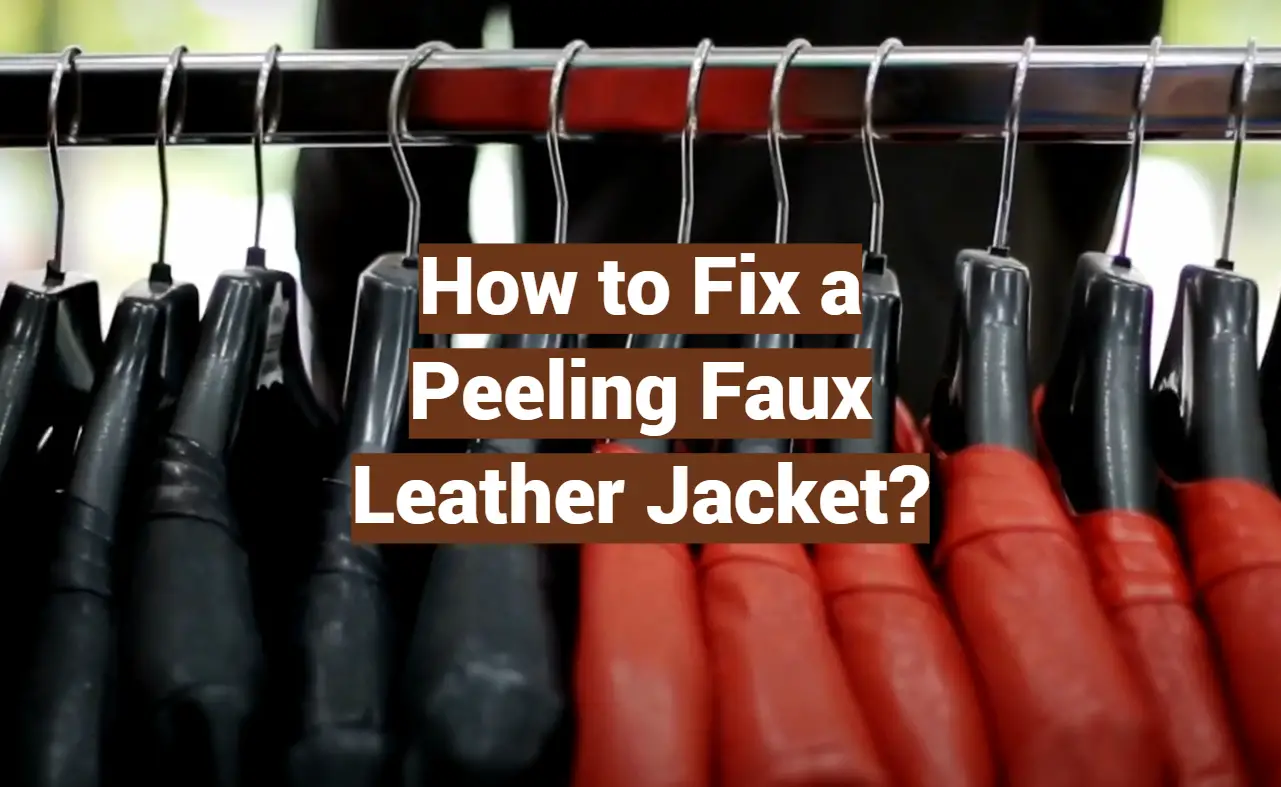
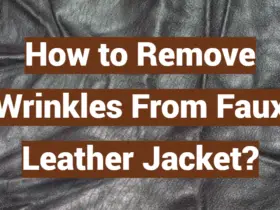




I’ve had a faux leather jacket for years that started peeling badly. After some research, I found that repairing peeling faux leather is totally doable at home. I used Fiebing’s Leather Dye and some sandpaper to fix my peeling faux leather jacket. I sanded down the cracked areas, applied thin coats of dye, and it looked great! The dye restored the color and sealed the cracks. Just be sure to properly prep and clean the area first. A bit of elbow grease brought my jacket back to life.
I had a faux leather jacket that was peeling and cracking in several spots. To repair the faux leather jacket, I used a leather filler compound I found at the craft store. I applied it carefully with a putty knife just to the damaged areas and smoothed it out. Once it dried, I sanded it down lightly. Then I used a flexible faux leather paint in a matching color to cover the repairs. Some light sanding and a coat of sealant, and my faux leather jacket looked as good as new!
The faux leather on my jacket started visibly cracking and peeling after a few years of wear. I looked into faux leather jacket repair methods and found that one of the most effective is using a faux leather repair kit you can pick up online or at a craft store. It has textured patches you can cut to size, special glues and acrylic paints made for the job. I followed the steps to adhere a patch over the damaged area, seamlessly blending it with acrylic paint. It held up great and gave my jacket new life!
I absolutely love my faux leather motorcycle jacket, so I was bummed when areas started peeling and flaking. Rather than buying a whole new jacket, I found a great solution for repairing my faux leather jacket. I used a clear flexible sealant designed for vinyl and leather apparel. I applied a thin coat with a small brush just to the damaged spots. It sank right in, bonding the lifting edges back down. It restored the integrity of the surface and prevented further cracking. Worked like a charm and saved me a bundle!
When the faux leather on my favorite jacket began visibly peeling, I looked for tips on how to fix faux leather jacket peeling. I found a really effective DIY solution. Using fine grit sandpaper, I lightly sanded the peeling pieces to rough up the texture. Then I applied a thin coat of rubber cement with a small brush and clamped the area to bond the peeling piece back down securely. Once dried, it was perfectly smoothed out! No more peeling. With a bit of touch up paint, good as new!
I was disappointed when the faux leather on my moto jacket started seriously peeling. After some research on repairing leather jacket peeling, I used a specialty leather filler compound to patch the spots, carefully smoothing with a plastic spreader. Once dry, I blended the repairs by stippling on a flexible faux leather paint. A few coats left a like-new finish! Saved me from having to replace a jacket I love. Just be sure to properly prep the area first and apply products sparingly. Worked beautifully though!
When I noticed some ugly peeling and cracks on my faux leather jacket, I looked into how to repair faux leather. An easy fix was using a textured iron-on faux leather patch cut to fit the damaged spot. I applied a leather adhesive to the jacket, smoothed on the patch, then sealed the edges carefully with a craft glue gun on low heat. Once it cooled, I used masking tape to compress the repair. The patched area blended right in, and the peeling was no longer visible. Much cheaper than replacing the whole jacket!
I had a faux leather biker jacket I wore constantly, until it started peeling along the snap closures. I was bummed but then learned how to fix faux leather peeling with flexible sealant designed for vinyl. I applied a thin coat along the peeling edges and clamped them to dry in place. It bonded the pieces back together seamlessly! Once I touched up the spots with matching paint, the repairs were undetectable. The sealant was a game changer for restoring my jacket and preventing further damage.
My favorite faux leather bomber jacket was peeling badly at the cuffs and collar. Rather than buying a pricey replacement, I repaired the faux leather jacket using a specialty adhesive patch kit. It came with textured patches in different colors and a bonding glue. I trimmed a patch to fit each damaged area, fused it on, then sealed the edges smoothly. The patches matched the jacket texture and colors perfectly! For under $20, I saved a jacket that would’ve cost $200 to replace.
I was irritated when the faux leather on my favorite moto jacket started cracking and peeling after only a couple seasons. Doing some research on how to fix a faux leather jacket, I found a great DIY solution. Using fine grit sandpaper, I roughened the damaged areas to help the repair adhesive stick. Then I applied thin coats of a flexible faux leather adhesive, smoothing with a spatula as I went until level. The adhesive blended right in, bonded the peeling pieces down, and prevented further damage!
My vintage-style faux leather jacket developed some unsightly cracks and peeling after years of wear. I looked into how to fix faux leather peeling jacket and found an effective repair method using cotton swabs and flexible faux leather sealant. I carefully applied the sealant just to the damaged spots and surrounding borders, blending gently with cotton swabs. It looked seamless once dried, and the peeling completely disappeared! The sealant brought my jacket back to life in no time. So glad I could salvage it!
I was bummed when my beloved faux leather jacket started visibly peeling and cracking in areas after regular wear. I researched can you fix peeling faux leather jacket and found you absolutely can make DIY repairs. I used thin layers of a specialty leather filler compound, smoothing between coats with plastic spreaders. Once fully dried, I blended with stippling-on coats of flexible faux leather paint. You’d never know there was damage – saved me a bundle over replacement cost! Just take your time with the patching process.